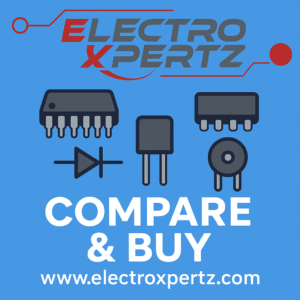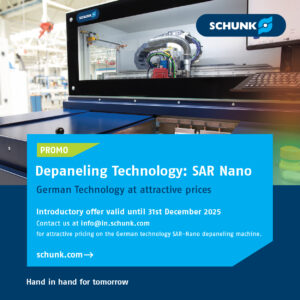Explore the details of the GYA, GYC, GYD, and UUD series.
Nichicon
- Nichicon Hybrid Capacitors
- Compliant with Automotive Electronic Council’s AEC-Q200
- The GYA, GYC, and GYD series capacitors
- The UUD series electrolytic capacitors
Nichicon is one of the most prestigious capacitor manufacturers on the market. The company’s components are characterized by excellent parameters and are popular – especially among manufacturers of electronic equipment focusing on the quality and durability of their devices. In recent decades, however, electronic circuits have become more widespread in new fields (e.g., automotive) and, at the same time, the requirements for their energy efficiency and durability have increased. This is the result of a constant technological development – especially in the field of capacitors. On the one hand, they remain a key component of many circuits (such as power supplies or converters), and on the other: for years they have been considered the most failure-prone passive components. Today the TME catalogue is full of compact elements with extended service life and excellent characteristics. What’s more, there are completely new technological solutions on the market that meet the high requirements of modern electronics. Nichicon capacitors are at the forefront of development – and you can always find the brand’s latest solutions at TME.
Nichicon Hybrid Capacitors
Electrolytic capacitors are widely used in electronic equipment – mainly due to the large capacities they offer, relatively small size, and finally: affordable price. However, electrolytic capacitors have their disadvantages (e.g., high impedance, limited lifetime, or high leakage current). To improve these parameters,a hybrid technologywas developed; the electrolyte function is performed by a conductive polymer separating the insulation and aluminium foil layers. This design allows for better characteristics of the capacitors, including: smaller size, longer life, and low ESR. Additionally, the nominal impedance does not change significantly with temperature. An example is shown in the diagram (Fig. 1.). It represents the change of equivalent series resistance (at 100 kHz frequency) against the operating temperature. Measurements were made for Nichicon components with comparable specifications: the UCZ series electrolytic capacitor and the GYA hybrid capacitor (the products are described below).
Fig. 1. Variation of ESR with operating temperature.

![]()
mpedance of UCZ series hybrid capacitor.
![]()
Impedance of GYA series hybrid capacitor.
Compliant with Automotive Electronic Council’s AEC-Q200
The international standard AEC-Q200 defines the characteristics of passive components approved for automotive designs. As vehicle components are exposed to a number of unfavourable factors, the AEC-Q200 certification provides, among others,thermal, humidity, and vibration resistance tests. Component parameters must have a certain tolerance. As part of the tests, the components are subjected to cyclical maximum loads to verify their service life. This is understandable considering that the operation of any capacitor can affect the correct operation of ABS, ESR and other safety features – and even the on-board computer. All of Nichicon’s capacitors meet the requirements of the AEC -Q200 standard and can be used in the automotive industry for the production of electronic equipment for vehicles – including EV’s or electric vehicles.
GYA, GYC, and GYD series capacitors
GYA, GYC, and GYD series capacitors are hybrid components manufactured according to the processes developed by Nichicon. The differences between the series are shown in the following table and relate mainly to the maximum operating temperature (the minimum temperature for all series is -55°C).
| Series | Capacitance (±20%) | Operating voltage | Maximum temperature |
| GYA | from 10 µF to 470 µF | from 16 V to 63 V DC | 125°C |
| GYC | from 10 µF to 330 µF | from 25 V to 63 V DC | 135°C |
| GYD | from 100 µF to 270 µF | from 25 V to 35 V DC | 150°C |
The presented series are SMD elements, compact and adapted for mass production (at rest, they tolerate PCB temperatures up to 250°C, provided that the soldering process lasts no longer than 30 seconds). They comply with the RoHS directive and the above-mentioned AEC-Q200 standard. It should be noted here that their capacitance tolerance is ± 20%. This is a result comparable to electrolytic capacitors with similar electrical characteristics. However, in addition to low impedance (low ESR) hybrid Solutions also stand out for long life and limited degradation. The diagram (Fig. 2) shows the average change in the capacitance of “classic” and hybrid capacitors. Data provided by the manufacturer indicates that GYA, GYC, and GYD series are four times less likely to lose capacitance under regular operating conditions.
Fig. 2. Change in capacitance over time.

![]()
Capacitance degradation of a typical electrolytic capacitor.
![]()
Change in capacitance of hybrid capacitors.
Hybrid capacitors from Nichicon are primarily used in power supplies, electric motor controllers , pumps, drivers lightning (e.g., cabin lighting), and measuring devices . Due to its standards and thermal tolerance, the GYD series can also be used in AC/DC, DC/DC converters and electric and hybrid car inverters, charging stations for these vehicles, as well as engine monitoring systems.
The UUD series electrolytic capacitors
Although the UUD series are SMD electrolytic capacitors – they are not much behind hybrid solutions. They are characterized by relatively low impedance and high thermal resistance. This confirms the quality of Nichicon components. The components are approved for use in the automotive sector. Capacitors are designed for high-density printed circuit boards like computer motherboards; tolerate temperatures from -55°C to 105°C, their leakage current does not exceed 3µA, and the guaranteed lifetime is (depending on the model) 2000h or 5000h. TME offers these products with capacitances from 10 µF to 470 µF (suitable for voltages from 10 V to 50 V DC).

The capacitors suitable for automotive circuits.
Text prepared by Transfer Multisort Elektronik Sp. z o.o.
The original source of text:tme.eu









